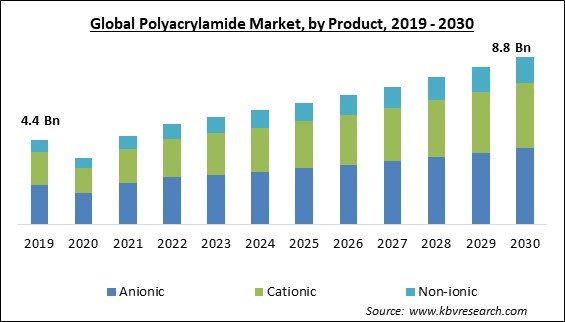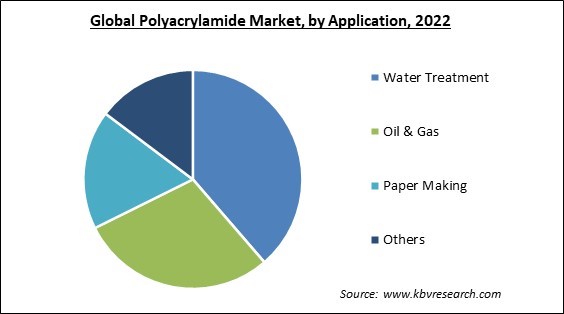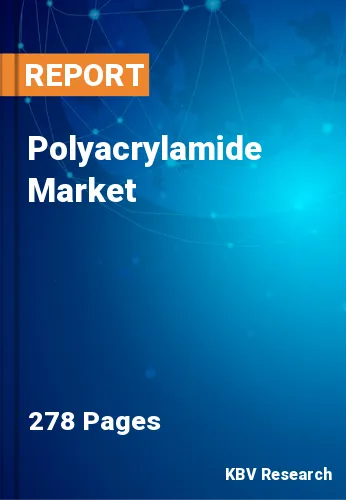The Global Polyacrylamide Market size is expected to reach $8.8 billion by 2030, rising at a market growth of 6.6% CAGR during the forecast period. In the year 2022, the market attained a volume of 2,999.4 Kilo Tonnes, experiencing a growth of 5.6% (2019-2022).
The United States, in particular, has experienced a boom in shale gas exploration and hydraulic fracturing (fracking) activities. Polyacrylamide is used in hydraulic fracturing fluids to improve water viscosity and enhance the recovery of natural gas and oil from shale formations. The shale gas industry's growth has boosted the demand for polyacrylamide-based products. Hence, the North America region would acquire 1/4th share of the market by 2030. Some of the factors impacting the market are efficient coagulation and flocculation properties of polyacrylamide, rapid urbanization and infrastructure development, and environmental concerns related to mismanagement and poor disposal.

However, the environmental impact of polyacrylamides (PAMs), mainly when not managed or disposed of properly, is a significant concern. Polyacrylamides are synthetic polymers typically non-biodegradable, meaning they do not break down naturally in the environment over short periods. This characteristic can lead to long-lasting pollution if not managed properly. Although PAMs are generally considered non-toxic, their breakdown products or contaminants present in PAM formulations can pose risks to aquatic life and ecosystems. This can include issues related to oxygen depletion, altered water chemistry, and potential harm to aquatic organisms. Therefore, these factors can negatively impact the market in the future.
On the basis of application, the market is divided into water treatment, oil & gas, paper making, and others. The water treatment segment recorded the maximum revenue share in the market in 2022. Governments and environmental agencies worldwide have implemented stringent regulations on water quality and wastewater discharge. This has prompted industries and municipalities to invest in advanced water treatment processes, where polyacrylamides are crucial in removing impurities and contaminants. As a result, the demand in the segment is expected to increase in the future.

Based on product, the market is segmented into anionic, cationic, and non-ionic. In 2022, the cationic segment garnered a significant revenue share in the market. Cationic polyacrylamides are extensively used in water and wastewater treatment processes. Their positively charged nature allows them to effectively bind with negatively charged particles and contaminants in water, such as suspended solids, organic matter, and pollutants. As ecological regulations become more stringent globally, the demand for efficient water treatment solutions has risen, and cationic polyacrylamides have proven effective in improving the quality of treated water. Owing to these factors, the cationic segment will proliferate in the upcoming years.
| Report Attribute | Details |
|---|---|
| Market size value in 2022 | USD 5.3 Billion |
| Market size forecast in 2030 | USD 8.8 Billion |
| Base Year | 2022 |
| Historical Period | 2019 to 2021 |
| Forecast Period | 2023 to 2030 |
| Revenue Growth Rate | CAGR of 6.6% from 2023 to 2030 |
| Number of Pages | 278 |
| Number of Table | 530 |
| Quantitative Data | Volume in Kilo Tonnes, Revenue in USD million, and CAGR from 2019 to 2030 |
| Report coverage | Market Trends, Revenue Estimation and Forecast, Segmentation Analysis, Regional and Country Breakdown, Companies Strategic Developments, Company Profiling |
| Segments covered | Product, Application, Region |
| Country scope | US, Canada, Mexico, Germany, UK, France, Russia, Spain, Italy, China, Japan, India, South Korea, Australia, Malaysia, Brazil, Argentina, UAE, Saudi Arabia, South Africa, Nigeria |
| Growth Drivers |
|
| Restraints |
|
By region, the market is segmented into North America, Europe, Asia Pacific, and LAMEA. In 2022, the Asia Pacific segment acquired a considerable revenue share in the market. The demand for polyacrylamides in water and wastewater treatment will remain strong in APAC. As population growth, urbanization, and industrialization continue, the need for adequate water purification and treatment solutions increases. Polyacrylamides are essential in flocculation and sedimentation processes for water clarification. As a result, there will be an increased demand in this regional market.
Free Valuable Insights: Global Polyacrylamide Market size to reach USD 8.8 Billion by 2030
The market research report covers the analysis of key stake holders of the market. Key companies profiled in the report include Anhui Jucheng Fine Chemicals Co., LTD, Ashland, Inc., BASF SE, Kemira Oyj, SNF Group, Black Rose Industries Ltd., Shandong Baomo Biochemical Co., Ltd., Xitao Polymer Co., Ltd., The Dow Chemical Company (Dow Corning Ltd.), and Solvay SA.
By Product (Volume, Kilo Tonnes, USD Million, 2019-2030)
By Application (Volume, Kilo Tonnes, USD Million, 2019-2030)
By Geography (Volume, Kilo Tonnes, USD Million, 2019-2030)
The Market size is projected to reach USD 8.8 billion by 2030.
Efficient coagulation and flocculation properties of polyacrylamide are driving the Market in coming years, however, Environmental concerns related to mismanagement and poor disposal restraints the growth of the Market.
Anhui Jucheng Fine Chemicals Co., LTD, Ashland, Inc., BASF SE, Kemira Oyj, SNF Group, Black Rose Industries Ltd., Shandong Baomo Biochemical Co., Ltd., Xitao Polymer Co., Ltd., The Dow Chemical Company (Dow Corning Ltd.), and Solvay SA.
In the year 2022, the market attained a volume of 2,999.4 Kilo Tonnes, experiencing a growth of 5.6% (2019-2022).
The Anionic segment is leading the Market, by Product in 2022, and would continue to be a dominant market till 2030; thereby, achieving a market value of $4 Billion by 2030.
The Asia Pacific region dominated the Market, by Region in 2022, and would continue to be a dominant market till 2030; thereby, achieving a market value of $4.9 Billion by 2030.
Our team of dedicated experts can provide you with attractive expansion opportunities for your business.

